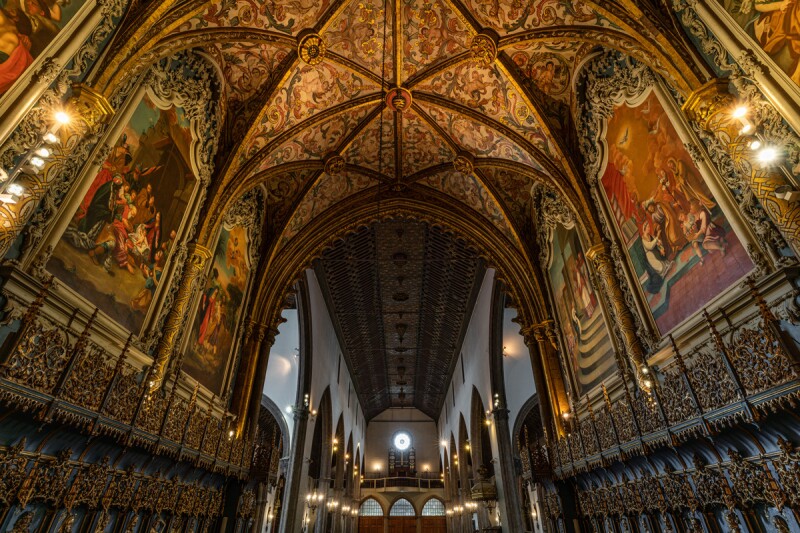A Portuguese archipelago off the coast of Africa, Madeira offers much more than adventurous hiking and its striking coastal landscape (although it has that, too). An ideal destination for travelers who are passionate about art, architecture, cuisine, and more, the islands’ rich history and culture span upwards of six centuries. In Madeira, there is always something to discover, from traditional palheiros houses which date to the 1500s and inviting fishing towns to time-honored arts and crafts and traditional toboggan rides or “carros de cesto.”
Meanwhile, food lovers will be amazed by the fresh flavors of Madeira’s cuisine, based on local ingredients from the land and sea, as well as the region’s distinctive fortified wine. Visit during one of the area’s famous holidays—such as the Flower Festival in May, the Wine Festival in August, and New Year’s Eve—and you’ll learn why it seems Madeirans are always celebrating. Read on to discover how you can tap into Madeira’s lifestyle and spirit throughout the year.

Forte São João Batista.
Photo by Digital Travel Couple
Hitch a ride
No visit to Madeira is complete without a stop in Monte, a hillside parish boasting panoramic views over Funchal and the magnificent Monte Palace Tropical Garden. To get there, take the cable car up from Funchal, the capital city of the Madeira archipelago—but the trip back down is even more memorable.

Carros de cesto, basket toboggans controlled by professional drivers, are an unforgettable way to get around in Madeira.
Photo ©Nuno Andrade
Enjoy a ride down the hillside via the iconic carros de cesto or basket toboggans, made from wicker and wooden skids and controlled by professional drivers wearing boots with thick rubber soles as brakes. These traditional vehicles first appeared during the 19th century to carry wealthy aristocrats and supplies from Monte to Funchal.
Eat your way around town
For a true taste of Funchal, book a food tour of the city and discover some of the region’s most unique (and delicious) dishes, including tuna steak with fried corn, Madeira honey cake, and limpets, a type of sea snail only found on volcanic islands. Adventurous eaters can try the Madeiran specialty of black scabbardfish, a deep-sea fish caught at depths of 2,000-5,000 feet, which is typically served with banana or fried on a sandwich. On a specialized, separate tour, wine obsessives can visit the island’s countryside, meet the area’s most emblematic Madeira wine producers in Porto Moniz, San Vicente, and beyond, and learn how fortified wine is made.
Check into a historic hotel

The pool surrounded by gardens at Quinta de Casa Branca
The former manor houses of local families, quintas often belonged to English merchants who settled in Madeira to capitalize on the flourishing wine trade. A mix of the local and British style, these elegant manors feature romantic gardens, century-old trees, and old-world architecture. Quinta de Casa Branca offers gourmet dining and luxury accommodations, while The Villa at Quinta Jardin do Lago, built in the 18th century, provides guests with an oasis of botanical gardens, green hills, and a refreshing pool.
Get artsy
Bring some of Madeira’s heritage home with you by investing in a piece of traditional embroidery. Sewn entirely by hand, this centuries old craft first emerged to decorate household items, clothing, and churches. Each work—made from linen, cotton, natural silk, or organdy—may take up to several months to produce and must go through the approval of the Madeira Institute of Wine, Embroidery, and Handicrafts, which certifies its authenticity. You can find Madeira’s embroidery featured in tablecloths, sheets, scarves, clothing, and more in stores such as Bordal-Bordados da Madeira or at markets like Mercado dos Lavradores, which also sells other regional handicrafts like leather shoes and woven baskets.

Funchal Cathedral
Photo by Ricardo Faria Paulino-DRC
Hit the road
For a convenient way to view Madeira’s jaw-dropping landscapes and significant cultural sites, consider booking a jeep tour or renting a car. Be sure to stop by Teatro Municipal Baltazar Dias, São Tiago Fortress, Funchal Cathedral, the Mudas (Museum of Contemporary Art), and Câmara De Lobos, a local fisherman’s village where you can try poncha, a traditional rum drink, and admire the views of the coastline.
Step into the past
Experience historic Madeira with a visit to classic palheiros or Santana houses, one of the most iconic images of the region. Dating back to the 1500s, these small, colorful wooden homes feature a triangular straw roof with a high slope for waterproofing. Originally found in the countryside, today you can spot them in Santana’s city center and in Madeira Theme Park, an exhibition dedicated to the history, science, and tradition of the Madeira Islands.
Revel with locals

Flower Festival.
Photo by Henrique S.
Madeira loves a holiday and throughout the year you’ll find many reasons to celebrate. In February, the entire Madeira archipelago breaks out in music and dancing for Carnival, while the Flower Festival in May honors the arrival of spring with thousands of blooms and weeks of celebration, including a magnificent parade. Oenophiles shouldn’t miss August’s Wine Festival, which consists of two weeks of music, drinking, and street performances that culminates in the Feast of the Harvest.
Come during Christmas and New Year, you can witness cultural traditions such as the Missas do Parto (the Childbirth Masses), held nine days before Christmas, as well as the famous fireworks show on New Year’s Eve, once named by the Guinness Book of World Records as “the greatest fireworks show in the world.”











